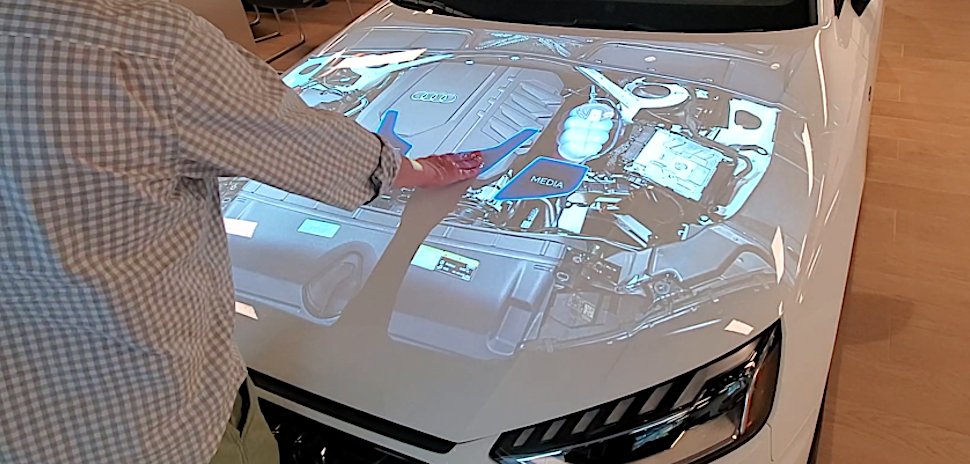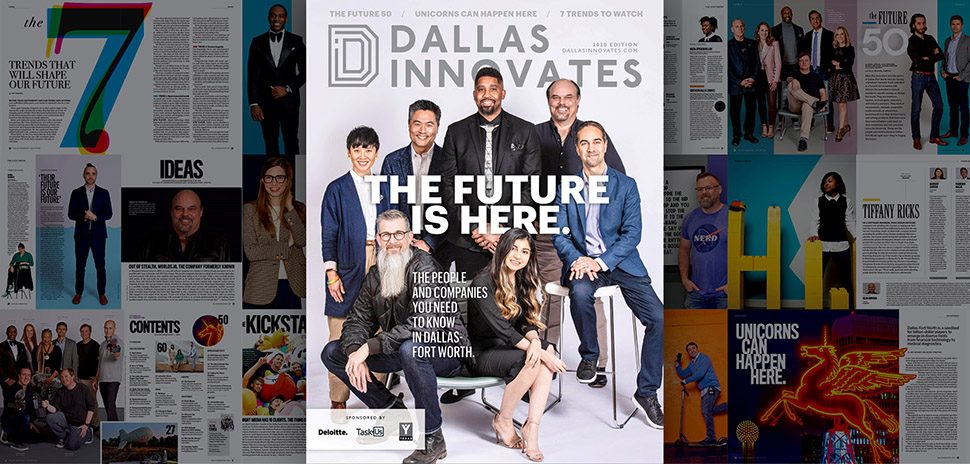Why walk your whole store taking inventory when a robot can do it for you, while you watch from anywhere? That’s the idea behind a new “virtual store walkthrough” feature from Dallas-based Spacee.
Spacee offers computer vision and AI solutions designed to help businesses drive new insights, improve efficiency, and boost revenue. Its Deming shelf-mounted robots (seen above), are able to roam across shelves capturing inventory data unobtrusively. Spacee says that while it can take several days for staff members to capture inventory manually—and a “full day for a floor robot”—Deming can provide “an accurate inventory accounting of an entire facility in under a minute.”
And now, with a new version of Deming launched last week, the shelf robots have live video feed capabilities, “allowing retail store managers to see shelves and get real-time inventory snapshots remotely.”
Closing a ‘huge gap’

Skip Howard, Spacee [Photo: Skyler Fike/Dallas Innovates]
“There’s a huge gap between what data retailers can collect in their e-commerce operations and what they can get from physical stores,” Skip Howard, founder and CEO of Spacee, said in a statement. “Spacee helps fill that gap with critical in-store customer and supply chain data. Our latest Deming robots now take it to the next level with live and recorded video feeds.”
Installing a Deming system requires “just one tool and about 30 minutes per aisle,” the company says.
Improving ‘supply chain efficiency’
Deming helps retailers improve supply chain efficiency, ensure Planogram compliance, reduce stockouts and waste, and reduce costs, Spacee says. The robots also provide “critical inventory data for retailers who pick e-commerce orders out of stores.”
“Supply chain challenges are making real-time inventory snapshots more crucial than ever,” Howard said. “Deming helps retailers get better visibility into what’s on their shelves, and what needs to be replenished from warehouses to reduce stockouts and keep customers happy. Deming’s new live video feeds will make it even simpler for district managers to quickly assess what help might be needed at each location, from anywhere.”
The company says its Deming robots are “the only retail inventory measurement solution that provides accurate, near real-time data with the view-anywhere video walkthrough feature. Retailers are able to use the system for video walkthroughs alone, or add extra capabilities including inventory tracking.
Spacee also offers HoverTouch technology

Spacee HoverTouch technology. [Video still: Spacee]
Perot Jain-backed Spacee was launched in 2013. Using light and motion, the company’s patented technology has also led to HoverTouch, a custom augmented reality solution that lets a customer interact with 2D and 3D surfaces by “hovering” their hand above projected images. We wrote in June about HoverTouch being used at Audi Dallas (above).
Another feature Spacee built in is HoverTouch Connect, which gives retailers, brands, and their agencies control of content, UX, and device management while providing actionable data. The plug-and-play solution can be installed in minutes with no manual calibration or tweaking needed.
Spacee works with leading brands including Audi, Walmart, Panasonic, Coca-Cola and Mercedes-Benz.
CEO offers four predictions for retail in 2023
Looking ahead to 2023, Spacee founder CEO Skip Howard has offered four predictions on retail tech trends.
One, “retailers will have to automate more.” Delivery route optimization and advances in inventory replenishment will be driven by “higher costs of labor and inventory costs with simultaneous downward pricing pressure from competition,” Howard said in a statement.
Two, “Customer experience will strike back against e-commerce.”
“When governments lifted COVID restrictions, it was like Black Friday for weeks,” Howard said. “There is a desire to be out and shop.” Spacee believes that retailers who provide a blend of digital/physical experiences will be best positioned to draw customers back into stores. The company noted several examples of e-commerce moving into physical because of that (including Neighborhood Goods and Amazon). “Computer vision applications like Spacee HoverTouch, facial recognition, AR filters (virtual dressing rooms, makeup, etc.), sentiment analysis, robotic cooks, robot in-store deliveries, immersive art, and more will all explode in the next year,” Howard’s forecast said.
Three, Howard believes “practical frictionless retail is farther off than we think.”
Amazon is leading a rush to move to “just walk out” technology, Howard noted. But existing technologies are limited to a curated product set and require a Planogram to work—and when retailers move items, a human has to come fix it for Planogram compliance. “The technology really needs to evolve for frictionless retail to move out of the beta environment,” Howard said.
Finally, Howard predicts that AI will identify trends retailers wouldn’t have thought to explore, in a very granular way.
“We’re not talking about determining how weather affects sales,” he said. “That will feel like child’s play. At a much more granular level, AI will be able to make micro changes that affect macro results.” The only way to get that type of data, he adds, is by ultra-granular measurements—”and to do that you need in-store cameras mixed with data science. The shopping trends that we’ll uncover with data science will be unimaginable and unknowable today.”

Brad Anderson
Spacee recently added former Best Buy CEO to its advisory board
Last month, Spacee added Brad Anderson, Best Buy’s former CEO and vice chairman, to its advisory board.
He joined three other members: Brad Crutcher, former COO and CEO of Texas Instruments, Duncan MacFarlane, Professor of Electrical Engineering at Southern Methodist University; and Jeff Wellen, who’s held leadership roles at retailers including Michaels Stores, Fossil, and Tuesday Morning.
You can read more about Anderson’s Spacee connections (he’s also an investor) by reading this.
![]()
Get on the list.
Dallas Innovates, every day.
Sign up to keep your eye on what’s new and next in Dallas-Fort Worth, every day.






























